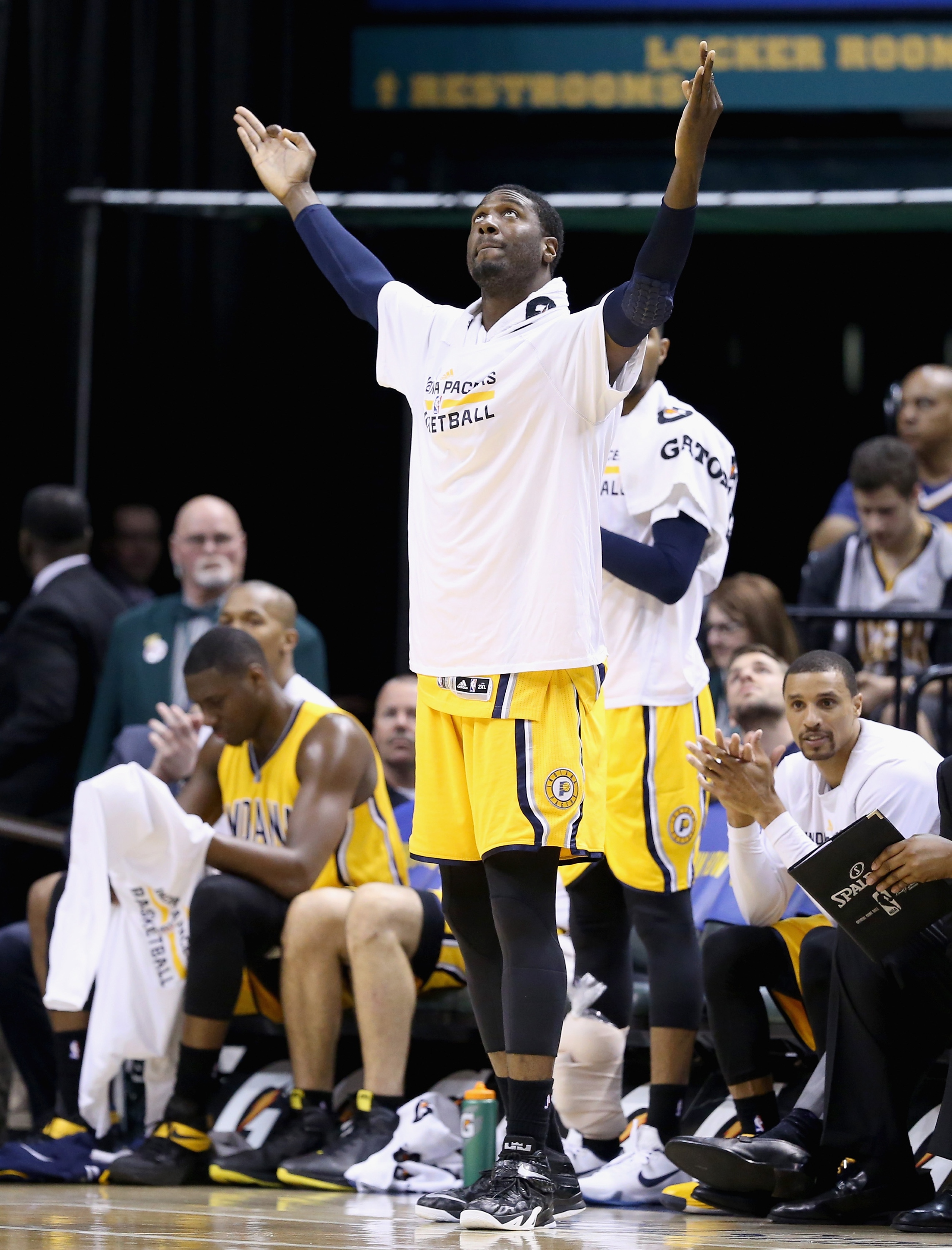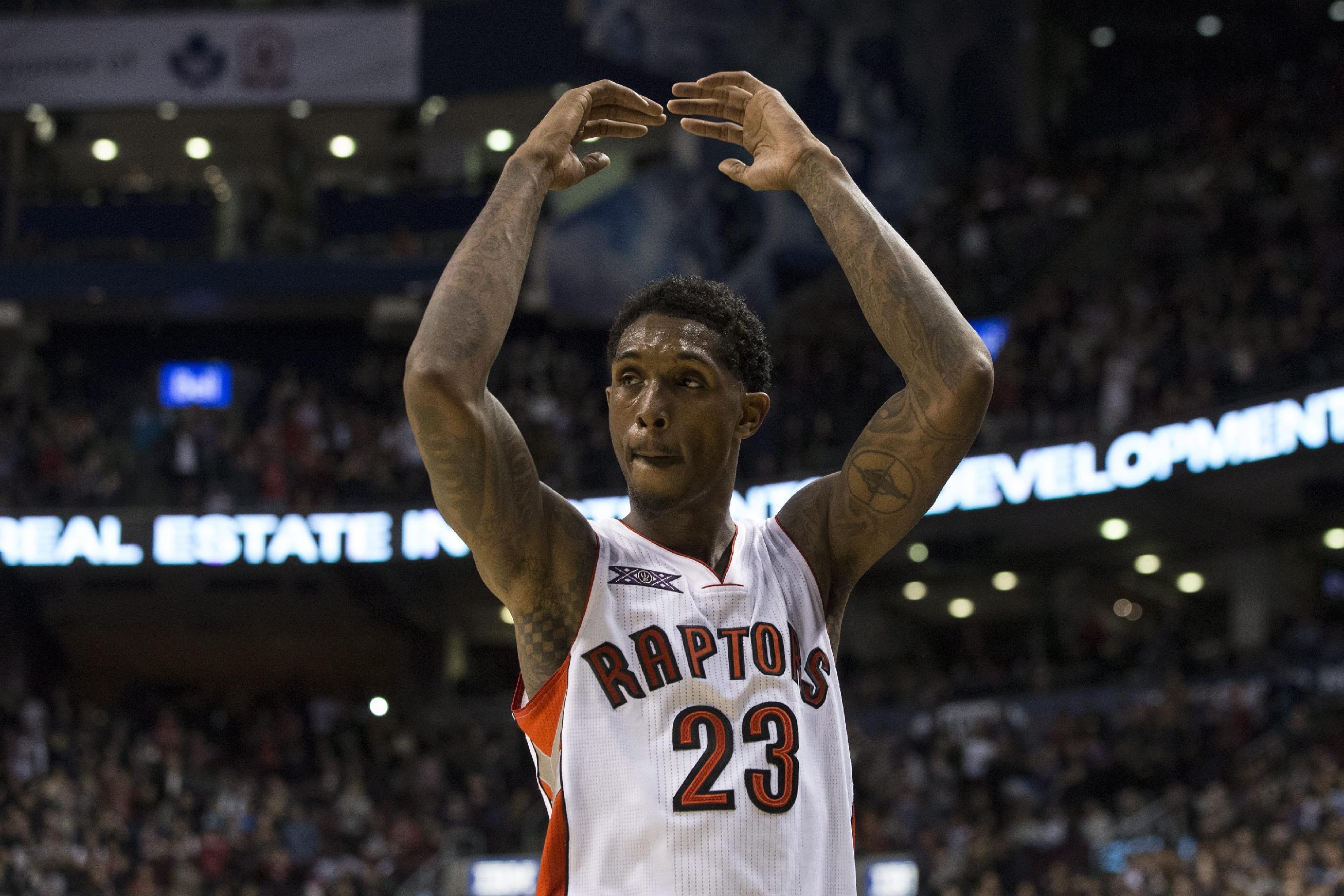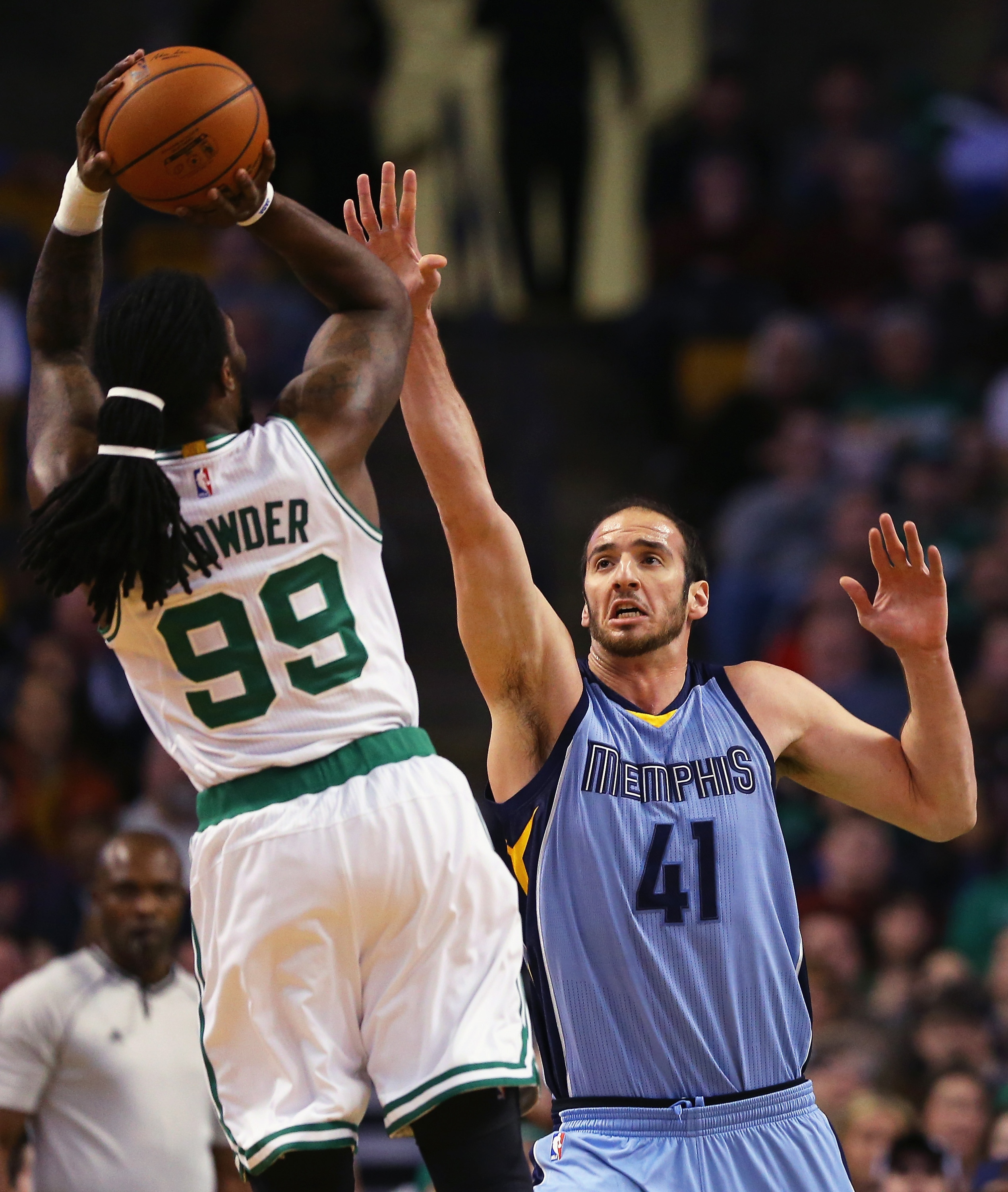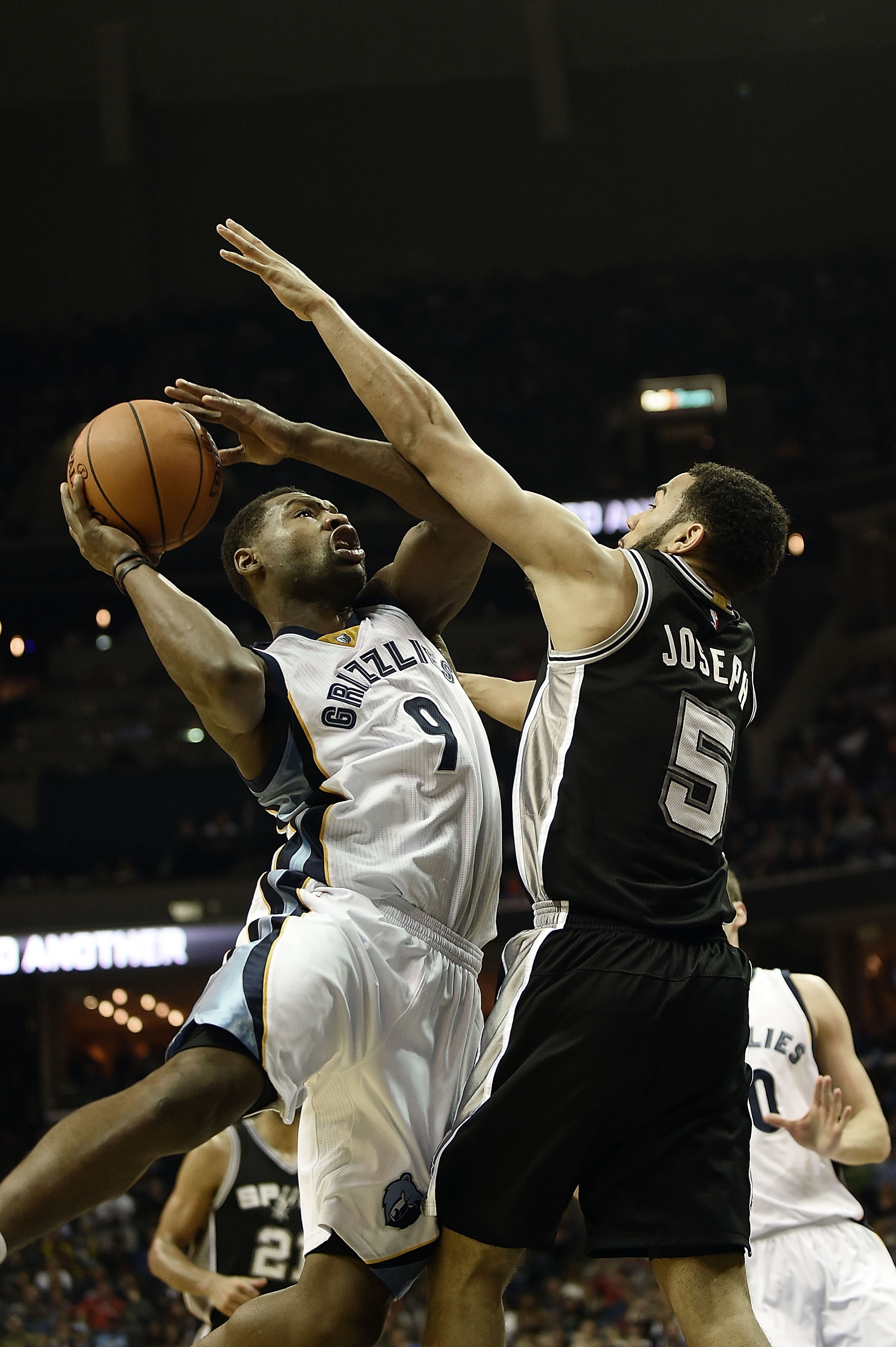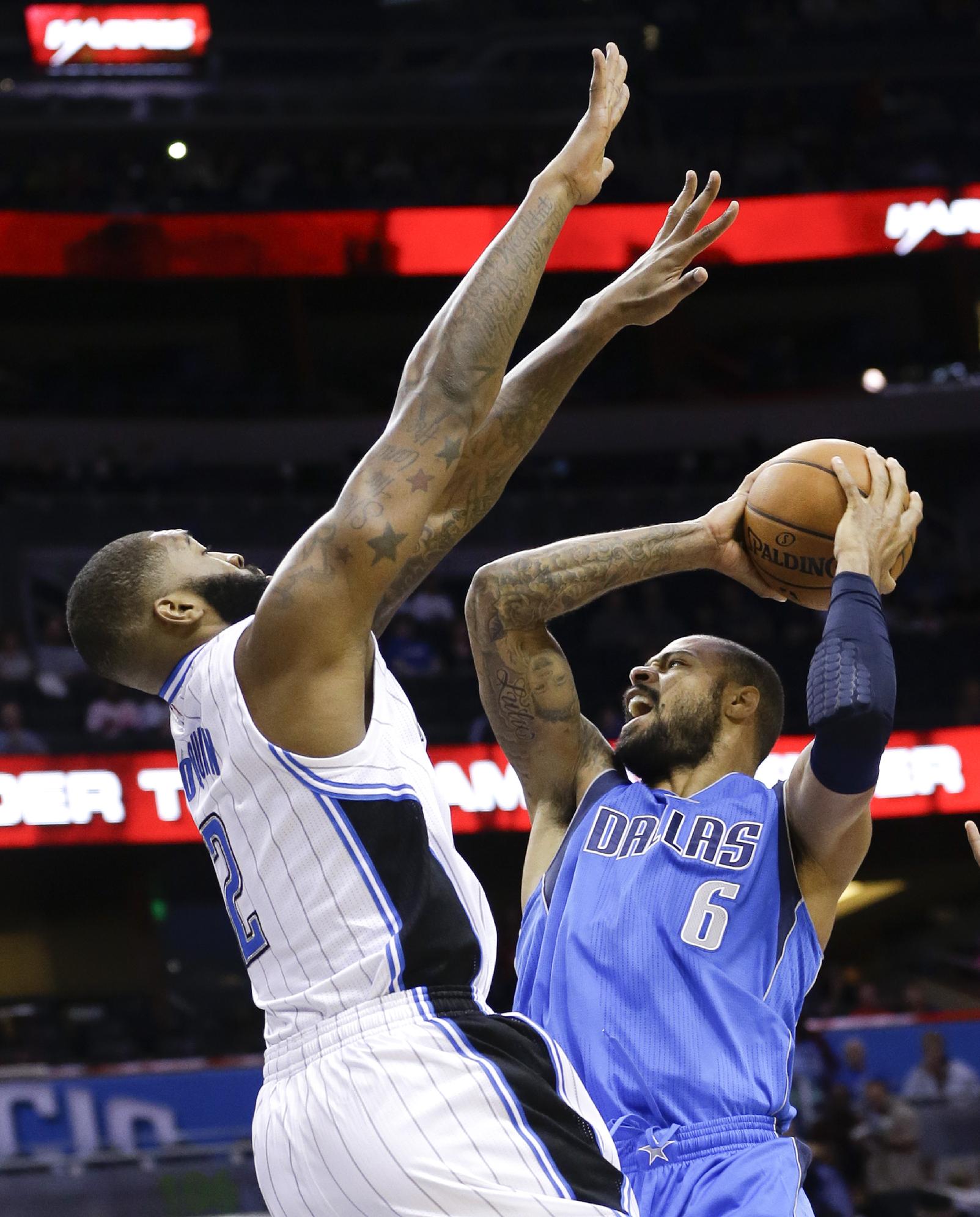Free-agent roundup: Lakers and Kings move on, Rox and Raps D up, Knicks and Stuckey stay course
Just about all the big fish in the 2015 NBA free agency period have agreed to terms to either stay put or move on, but the deals continue apace as teams work to fill out their rosters. Let’s take a look at some of the lower-tier deals agreed to in the post-superstar period, starting in Hollywood.
***
Lakers downshift with deals for Hibbert, Williams, Bass
After missing out on top free-agent bigs LaMarcus Aldridge, DeAndre Jordan and Greg Monroe, who’s headed to the Milwaukee Bucks on a three-year max deal, Los Angeles Lakers general manager Mitch Kupchak set about the business of rounding out his roster … starting with the glaring hole in the middle that he left unfilled by choosing Ohio State guard D’Angelo Russell rather than Duke center Jahlil Okafor with the No. 2 overall pick in June’s 2015 NBA draft.
Yahoo Sports NBA columnist Adrian Wojnarowski reported that the Lakers are finalizing a trade with the Indiana Pacers that will import Roy Hibbert, a deal that will cost the Lakers only a future second-round draft pick in exchange for using their cap space to absorb the $17.8 million owed to the 7-foot-2 center in the final year of the max contract he received three summers ago. Hibbert’s 2015-16 salary is listed at $15.5 million, but his contract includes a 15 percent trade kicker that any team acquiring him must pay out upon completion of a trade. The Lakers could also insist on some sweeteners as a tax for renting out their cap space, including a potential future pick and/or forcing the Pacers to take on a current player, such as center Robert Sacre or power forward Ryan Kelly, in order to open up additional cap space as the Lakers retool their roster.
The two-time All-Star rim protector will reportedly be joined in the rebuilt Lakers frontcourt by power forward Brandon Bass, late of the Boston Celtics, whom Woj and fellow Yahoo Sports NBA columnist Marc J. Spears report will be heading to the West Coast, but whose specific contract details have yet to be ironed out due to the uncertainty that will surround the Lakers’ cap situation until the Hibbert trade gets squared away. Kupchak also made a move to add some backcourt punch, agreeing to terms on a three-year, $21 million deal with reigning Sixth Man of the Year Lou Williams.
Lakers fans might not find any of the three moves particularly thrilling, but each could have a meaningful positive impact on a talent-poor L.A. club that ranked 23rd among 30 NBA teams in offensive efficiency last season while also turning in the league’s second-worst defense, allowing a whopping 108 points per 100 possessions.
There’ve been plenty of digs at Hibbert’s offensive ineffectiveness over the years, and frankly, they’ve been justified. The 28-year-old big man has never shot better than 50 percent from the field or averaged 13 points per game in seven NBA seasons, and has often seemed unable to anchor his massive frame on the block, or able to produce anything more fluid than largely awkward half-hooks and turnaround flings after being pushed off his spot.
With big men capable of both running and stretching the floor increasingly in vogue as the NBA game evolves and smaller, more versatile lineups carry the day, the 7-foot-2, 280-pound Hibbert looks like a plodding anachronism, to the point where even head coach Frank Vogel and team president Larry Bird spoke openly after the season about the possibility that Hibbert would face a diminished role if he returned to Indiana, as the team looked to play smaller and faster, with Paul George seeing more time at power forward. (Those comments didn’t sit right with Pacers power forward David West, who opted out of the final year of his deal and is looking for greener pastures.)
Hibbert’s fate seemed all but sealed before the draft, given the Pacers’ reported interest in more athletic and lithe Kentucky center Willie Cauley-Stein. It was all over but the shoutin’ after the draft, when the Pacers selected Texas big man Myles Turner — a 7-foot freshman with perimeter scoring skills who also profiles as a plus shot-blocker — with the No. 11 pick.
But while Hibbert might not fit the mold as a modern offensive center, he’s still one of the league’s premier interior defenders, a behemoth whose skill at going straight up and using his whole frame to protect the paint — that vaunted “verticality” about which announcers love to debate — helped define the “smash-mouth” style that led Indiana to top-10 finishes in defensive efficiency in each of the last four seasons. That includes two years as the NBA’s No. 1 defense and a No. 8 ranking last year, despite Vogel playing without former starting shooting guard Lance Stephenson and having George for just 91 minutes as he worked his way back from his horrific broken leg.
It’d be absolutely shocking if Hibbert was able to marshal quite that kind of improvement on a Lakers roster that doesn’t feature very many (if any) quality defenders. But he could give Byron Scott a fundamental organizing principle around which to build on that end — funnel everything at the big guy — while helping young players like rookies Russell and Larry Nance Jr., 2014 lottery pick Julius Randle and rising sophomore point guard Jordan Clarkson as they try to find their footing when it comes to playing NBA defense. For a Lakers side that’s really trying to find anything to build on as it attempts to move out of this all-too-rare stay in the NBA’s basement, that’s something, at least.
Williams certainly won’t help that leaky defense, but he could offer a similar injection of credibility on the offensive end. The veteran shooting guard averaged a career-high 15.5 points per game for the Raptors last season, and while he wasn’t terribly efficient in doing so — he shot just 40.4 percent from the field and 34 percent from the 3-point line, right in line with his career averages — he did tend to make sure that the Raptors got something out of the plays he commandeered, posting the league’s 16th-best turnover rate by coughing up the ball on a microscopic 8.4 percent of the possessions he used.
He uses his handle, quick first step and playmaking smarts to get to the line a ton, averaging 4.9 free-throw attempts despite playing just 25.2 minutes per game in Toronto last year, and has converted freebies at an 81.6 percent clip for his career. For an offense that bogged down early and often last season, Williams is the kind of guy to whom the Lakers can turn to get a shot off, if nothing else.
The Lakers, of course, already employ two shooting guards who like to get shots up with questionable levels of efficiency and effectiveness, and now employ a pair of young ball-handlers in Russell and Clarkson who figure to need the ball in their hands to contribute on offense. But Kupchak’s reportedly looking to offload the remaining three years and $16.3 million on Nick Young’s contract in trade, the two young point men are still longer on potential than production, and the health of Kobe Bryant remains very much an open question after three consecutive season-ending injuries. (The Laker braintrust could also very well prefer to slot Bryant in at the three in smaller lineups rather than have him play many minutes in the backcourt.)
The 28-year-old Williams, then, offers a measure of ball-handling and volume-shooting insurance should someone else be unavailable or ineffective, or if another roster move comes down the pike. He’ll get $7 million per year to do so because the salary cap’s going up and, at this point, the Lakers have to pay a little extra.
It’s difficult to say too much about Bass’ deal since we don’t exactly know what it is. Eric Pincus of the Los Angeles Times and Basketball Insiders suggests the Lakers are either earmarking Bass for their $2.8 million “room exception” or trying to offload more salary — Young, Kelly, Sacre, someone else — to be able to offer him a bit more money, too, on top of maximizing flexibility after absorbing Hibbert’s deal.
Assuming Kupchak doesn’t decide to max him out or anything, Bass figures to be the sort of player whose signing offends no one. He’s a 6-foot-8, 240-pound power forward who makes about 50 percent of his shots, shoots primarily midrange jumpers, and works hard on both the glass and defense. He’s had to accept a wide variety of roles and assignments over the years, developing from a spot-usage dirty-work type in New Orleans and Dallas into a starting four in Orlando before heading to Boston, where served as both a utility big on veteran teams trying to contend for championships and a veteran presence on young teams in the early stages of rebuilding.
He’s a durable, reliable, hard-working power forward, and while his presence creates a bit of logjam in the L.A. frontcourt alongside the likes of Hibbert, Sacre, Kelly, Randle, Nance and Tarik Black — pending trades that could ship out one or more of the incumbents — he’s the type of professional who could provide both a positive example for the Lakers’ young bigs and solid bang-for-your-buck production.
None of these deals, by any stretch, figure to move the Lakers significantly closer to postseason contention in a loaded Western Conference. In fact, they could wind up coming back to bite the Lakers, who still owe a top-three-protected first-round pick to the Philadelphia 76ers. (They sent it to the Phoenix Suns in the Steve Nash deal, and the Suns sent it to Philly in this February’s three-way dance that landed them Brandon Knight.) This season, the Lakers finished with the league’s fourth-worst record, but got a lucky bounce of the ping-pong balls on lottery night to rise up to the No. 2 spot that allowed them to keep their pick and select Russell. But the more wins the Lakers secure, the lower their likelihood of landing in that top three again.
It feels odd to look at a team that made three reasonably large veteran acquisitions and say, “Maybe they’ll get lucky and they won’t be too much better.” Alas, that’s the state of play in Hollywood these days.
Kings bounce back with deals for Koufos, Belinelli, Casspi
The Sacramento Kings clawed their way back toward zero after their disastrous start to free agency by reaching agreements with three players who should help George Karl’s crew look more potent and stable (ha!) next season.
Vlade Divac imported center Kosta Koufos, late of the Memphis Grizzlies and a Karl favorite during their time together with the Denver Nuggets, on a four-year, $33 million deal, and brought back forward Omri Casspi on a friendly two-year, $6 million deal, both according to ESPN.com’s Marc Stein. He also added shooting guard Marco Belinelli, formerly of the San Antonio Spurs, on a three-year, $19 million deal, according to Stein’s colleague, Ramona Shelburne.
None of the three profile as major-league game-changers, but each can contribute in real ways to an NBA team. Belinelli wasn’t as good or productive last season as he was in helping the Spurs win the 2013-14 NBA title, but even as a reserve who missed 20 games and posted the second-lowest 3-point shooting percentage of his career, he still made more 3-pointers than every King besides Ben McLemore and hit them at a higher clip than any King save Casspi. His shooting should help provide more space on the interior for world-eater DeMarcus Cousins, and he’s a capable enough secondary ball-handler to be able to initiate supplementary stuff should Sacramento’s primary options stall out.
The 26-year-old Koufos was one of the more attractive non-star options on the free-agent big man market, a legit 7-footer who can move on defense and doesn’t gum up the works on offense. He was an underrated starter under Karl in Denver three seasons ago before heading to Memphis, slotting in behind Marc Gasol and becoming one of the league’s best backup centers for the past two years.
If Karl wants to go big, he can play next to Cousins as a rebounder (he cleared the defensive glass at a rate that would’ve ranked 13th in the league last season if he’d played enough minutes) and rim protector (opponents shot the same percentage against him at the rim last year as they did against Draymond Green and Tim Duncan, per SportVU) who doesn’t need many touches to be effective. If Karl wants to stay smaller with Cousins at the five and Rudy Gay at the four, Koufos can serve as a top reserve off the bench, affording Divac and Karl the opportunity to allow No. 6 overall pick Willie Cauley-Stein a bit of time and space to find his footing at the NBA level.
The deal will carry him through age 30, covering the remainder of his prime, and will cost Sacramento quite a bit less than the New York Knicks paid Robin Lopez for what could wind up being roughly commensurate per-minute production. There are far worse ways to spend a shade over $8 million a year than to lock up a 7-footer who provides flexibility and two-way competence.
The 27-year-old Casspi offers quite a bit of those two assets, too, giving Karl a 6-foot-9 swing forward who has seemed to do his best work in recent years as a floor-spacing small-ball four. He’s coming off arguably his best NBA season, averaging a shade under nine points, four rebounds and 1.5 assists in 21.1 minutes per game in Sacramento on career-high 48.9 percent shooting from the field and a 40.2 percent mark from long distance. He shot a blistering 46.2 percent from deep after Karl took over at the All-Star break, which you’d think could’ve earned him a prettier penny in a free-agent market in which no team ever seems to believe it has enough shooting … and yet, amid all the roiling chaos and palace intrigue surrounding Karl, Cousins and the Kings’ front office, the Israeli forward elected to stick with the team that drafted him for the relative pittance of $3 million a year.
The roster still feels unbalanced, with some minutes (and perhaps roster) management needed to unclutter the Cousins-Koufos-Cauley-Stein-Gay-Casspi tangle at the four and five spots, some uncertainty surrounding how the newly acquired Rajon Rondo fits in alongside incumbent point man Darren Collison, and legitimate questions as to whether McLemore, Belinelli and Casspi represent enough shooting to keep opposing defenses honest. And these three signings, plus Rondo and a flyer on former Spurs and Philadelphia 76ers guard James Anderson, don’t seem to push the Kings that much closer to contending for a lower-tier playoff berth in the crowded Western Conference. But they do offer some indication that Divac, roundly criticized for the Nik Stauskas-sacrificing salary dump that created cap space that several Sacramento targets declined to take, has some idea what he’s doing as the Kings’ jagged-line attempts to build a winner continue.
Rockets stand pat, solidify defense with Beverley, Brewer
Fresh off their first Western Conference finals trip since 1997, the Houston Rockets focused on keeping their own players, agreeing to terms on a four-year, $25 million contract to bring back restricted free agent point guard Patrick Beverley and a three-year, $24 million deal to keep reserve swingman Corey Brewer in the fold, as reported by Yahoo Sports NBA columnist Adrian Wojnarowski. Both moves seem aimed at solidifying the gains Houston made on the defensive end last season, as Kevin McHale’s club improved from 12th in the NBA in points allowed per possession in 2013-14 to sixth last season, despite losing interior defensive centerpiece Dwight Howard for half the season due to injuries.
Beverley has established himself as one of the league’s premier defenders at the point of attack, a hard-nosed and active deterrent who excels at fighting around screens and lives to make opposing ball-handlers uncomfortable with his physicality and aggressiveness. He’s not a top-flight playmaker or shot-creator off the bounce, but with All-NBA shooting guard and MVP runner-up James Harden spending the majority of his time on the ball, he doesn’t need to be.
He needs to hit spot-up 3-pointers and looks from the short corners created by Harden’s drive-and-kick work, both of which he did at a not-great-but-pretty-good 38 percent clip last season, and he needs to defend like a bat out of hell. If he does that and manages to stay healthy — no sure thing, as the hard-charging point man has suffered serious late-season injuries in consecutive campaigns — a deal that will carry Beverley through age 30 and that USA TODAY’s Sam Amick reports will descend in annual salary over the course of the first three years before becoming a highly movable (just ask Luke Ridnour) $5 million unguaranteed salary in its final season could wind up being something of a steal for Daryl Morey.
Speaking of steals, Brewer ranked fourth on the Rockets in thefts last season despite playing just 56 games after his mid-December acquisition from the Minnesota Timberwolves in a three-team deal. The lanky 29-year-old swingman proved to be a stabilizing defensive force for McHale, helping the Rockets get funky with cross-matching and small-ball shifting with his ability to guard multiple perimeter positions. His gift for leaking out in the open court after opponents’ shots helps super-charge the Rockets’ transition attack, and he turned in some surprisingly important scoring performances in big games, most notably his 19-points-in-25-minutes explosion to help Houston stave off elimination in Game 6 of their second-round series against the Los Angeles Clippers.
He’ll always be a more willing shooter than a capable one — he attempted five triples per 36 minutes of floor time in Houston despite making just 28.4 percent of them — and I’d have some concern that his quickness- and athleticism-dependent game on both ends of the floor might not age exceptionally well. That shouldn’t be a major issue on a deal that only extends through the end of his age 31 season, though, and he figures to pair with Trevor Ariza and 2015 first-round pick Sam Dekker to give McHale, Daryl Morey and company one of the most versatile wing rotations in the league as the Rockets take aim at improving on last season’s second-place finish in the West.
Raps look to ramp up D with Joseph, Biyombo
Toronto Raptors general manager Masai Ujiri continued his efforts to bounce back from a second straight dispiriting first-round playoff exit by augmenting a defense that fell from ninth in points allowed per possession in 2013-14 to 23rd last season. He followed up his big-ticket splurge — a four-year, $60 million deal for rugged swingman DeMarre Carroll — with a pair of smaller line items.
Pickering, Ontario-born point guard Cory Joseph, late of the Spurs, will return to his home and native land on a four-year, $30 million deal, according to ESPN.com’s Chris Broussard. He’ll be joined by Congolese center Bismack Biyombo, who received a two-year, $6 million deal to bolster Toronto’s interior defense, according to Woj.
Joseph fought hard to carve out a niche for himself in San Antonio, shuttling back and forth from the big league to the D-League to work on his game when he couldn’t earn minutes behind the likes of Tony Parker and Manu Ginobili. He took advantage of the opportunity afforded him last season by Patty Mills’ post-shoulder-surgery rehab and earned his spot as the Spurs’ backup point guard, posting career highs in points, rebounds, assists and steals per game while shooting 50.4 percent from the field and 36.4 percent from the 3-point line.
The 6-foot-3, 185-pound guard also established himself as a tenacious defender, ranking in the 97th percentile among NBA defenders on spot-up shots and the 89th percentile on isolation possessions, according to Synergy Sports Technology’s play-charting data. Joseph should join with rangy first-round draft pick Delon Wright to give Ujiri and head coach Dwane Casey some more defensive punch at the point of attack behind All-Star Kyle Lowry than last year’s reserve combo of Lou Williams and Greivis Vasquez; the Raptors loses some shooting, playmaking, free-throw generation and daring, but the powers that be are betting that they’ll rediscover some of that lost defensive edge.
While Joseph represents a classic success story as a late-first-round pick who earned his way into the good graces of one of the greatest coaches of all time on a perennial championship contender, Biyombo’s a different kind of archetype — the lottery pick drafted on the promise of exceptional physical tools that never quite developed into game-changing skills.
Charlotte chose Biyombo with the No. 7 pick in the 2011 draft, banking on him developing into a defensive cornerstone who could pair with fellow lottery selection Kemba Walker in propelling the then-Bobcats into a bright new youth-movement-led future. The 6-foot-9 Biyombo used his 7-foot-6 wingspan to protect the rim from the start, ranking in the top six in the NBA in block percentage in each of his first two full seasons, and actually swatted an even greater share of opponents’ shots in each of the last two seasons. He’s also quick and athletic enough to hold up somewhat when drawn away from the basket by floor-spacing opponents, and to recover back to protect the basket after being pulled outside; Charlotte allowed fewer points per 100 possessions with him on the court than off it in three of his four seasons.
Yet Biyombo saw his minutes cut in half from Year 2 to Year 3, and still averaged less than 20 minutes per game last season, in large part because he remains an extremely limited offensive player: a no-range dunker who struggles to catch passes, almost never throws them himself and can’t do very much offensively beyond set a screen, roll hard to the rim and crash the glass.
There’s value in that, though. For stretches this season, the Hornets’ offense operated better with Biyombo setting big screens, diving hard to the basket and sucking in help defenders than it did with Al Jefferson locking down the left block. At just 22 years old, he’s an upside play — a cost-controlled bet that he can make an interior difference for a team that just lost Amir Johnson’s rim protection and rebounding, and that just maybe, with the proper guidance, he could become something more.
Knicks fill out frontcourt with O’Quinn, former No. 2 pick Williams
The New York Knicks continued their low-key summer, agreeing to terms on a four-year, $16 million deal to acquire restricted free agent forward Kyle O’Quinn in a sign-and-trade with the Orlando Magic, according to Woj, and a two-year, $10 million deal with former No. 2 overall draft pick Derrick Williams, according to Broussard.
The 25-year-old O’Quinn gives the Knicks another big man who can set screens, defend the basket, clear the defensive glass and make smart passes in the half court. He’s not Marc Gasol or Boris Diaw, but he’s a functional two-way big man who looks like a good fit in the triangle offense preferred by president of basketball operations Phil Jackson and head coach Derek Fisher. He’s reasonably effective at working from the elbows and off the dribble, can score a little bit inside, hits his free throws, began experimenting with extending his range to the perimeter last season — 27.9 percent from 3-point land on just under one attempt per game in Orlando — and has worked to become a strong communicator on the back line of a defense.
The Flushing, Queens, native holds a player option for the fourth season that will allow him to re-enter free agency in the summer of 2018 if he continues to develop his talents on both ends, but for the next three seasons, he seems a sound bet to provide good bang for a comparatively small amount of James Dolan’s bucks. Williams represents more of a swing for the fences, a pricier gamble that Stop No. 3 will be the magic number to unlock the considerable potential the Minnesota Timberwolves saw when they picked him No. 2 in 2011, right after Kyrie Irving went off the board to Cleveland.
After shooting 51 percent from the shorter college 3-point line during his two years at Arizona, Williams has yet to crack league-average from long distance in four pro seasons. The 6-foot-8, 240-pound Williams has seemed a man caught between positions at the NBA level, a dreaded “tweener” with too little foot speed to survive at small forward, too little heft to bang with opposing power forwards, and too few two-way skills to exploit prospective matchup problems at either position on either end of the floor. He’s also perennially ranked among the league’s worst defenders at his position, both by the eye test and advanced metrics, including ESPN’s Real Plus Minus.
The lottery pick’s a lottery ticket for Jackson and Fisher. If the 24-year-old forward all of a sudden starts showcasing a sharper shooting stroke, more attentive defense and a heretofore-unevidenced playmaking streak that makes him a more natural than expected fit in the triangle, then the Knicks get a boost as they attempt to re-establish normalcy and return to competitive positioning after the worst season in franchise history. If he doesn’t, they can walk away after two seasons without having significantly compromised their future financial flexibility.
The upside is limited by the player option Williams holds for the 2016-17 season, allowing him to bolt after one year if he does have a surprisingly strong season, but you can still understand the reason for taking the risk, even if it’s hard to envision another team coming in at $5 million per year for a player who’s shown as little at the big league level as Williams has.
Pacers bring back Stuckey
Rodney Stuckey agreed to a three-year, $21 million deal to return to the Indiana Pacers, according to Shams Charania of RealGM. That’s a tidy raise over the one-year veteran’s minimum contract that Stuckey received last summer — one he earned by proving a capable-enough replacement in the backcourt for the departed Stephenson. He’ll also hold a player option for the third and final year of the deal, allowing him to re-enter free agency if he’d like to pursue a more lucrative longer-term deal in the summer of 2017, when he’ll be 31 years old.
Stuckey made 36 starts in his 71 appearances, often pressed into larger-than-expected duty for a Pacers squad with a gaping hole on the wing after Stephenson’s exit, the season-scuttling broken leg suffered by Paul George during Team USA duty and early-season injuries that sidelined starting point guard George Hill. He responded with one of his more effective seasons in several years, averaging 12.6 points, 3.5 rebounds and 3.1 assists in 26.4 minutes per game, shooting a career-high 44 percent from the floor and 39 percent from 3-point land. Hill got healthy in late January and returned to primary ball-handling duties in the starting lineup in early February, sending Stuckey back to the bench, where he really seemed to hit his stride as Frank Vogel’s sixth man, averaging 14.5 points on 45/44.2/81.3 shooting splits in 26.6 minutes per game off the pine over his final 26 outings.
After rebuilding his value following a less-than-stellar close to his tenure with the Detroit Pistons, Stuckey reportedly wanted to make like David West and dip to join a contender, but he’d also expressed interest in returning to Indiana. It seemed unlikely that the Pacers would have enough cap space left to offer him the kind of contract he’d be looking for, especially after Larry Bird opened up owner Herb Simon’s checkbook to give $44 million to another backcourt scorer in Monta Ellis.
But shipping Hibbert to the Lakers gave Indy enough flexibility to make it rain, and losing incumbent backup point guard C.J. Watson to the Orlando Magic gave Bird the motivation to keep another ball-handling playmaker in the fold alongside George, Hill, Ellis and returning shooter C.J. Miles. Stuckey will need to prove last season’s career-best long-distance marksmanship wasn’t a fluke in order to earn his $7 million a year, and he’s something of a defensive liability no matter which position he’s asked to check, but the 6-foot-5 combo guard could fit a number of different wing roles for a post-Hibbert-and-West Pacers squad that will reportedly experiment with going small early and often. You need perimeter players who can do stuff in order to lean on those looks, and whatever his game’s warts, Stuckey could well fit that bill.
– – – – – – –
Dan Devine is an editor for Ball Don’t Lie on Yahoo Sports. Have a tip? Email him at [email protected] or follow him on Twitter!
Stay connected with Ball Don’t Lie on Twitter @YahooBDL, “Like” BDL on Facebook and follow Dunks Don’t Lie on Tumblr for year-round NBA talk, jokes and more.
